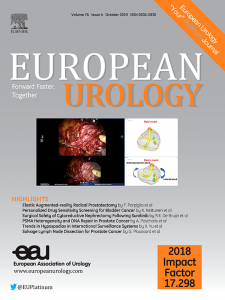Clinical Outcomes, Genomic Heterogeneity, and Therapeutic Considerations Across Histologic Subtypes of Urothelial Carcinoma
IF 25.2
1区 医学
Q1 UROLOGY & NEPHROLOGY
引用次数: 0
Abstract
Background and objective
Divergent differentiation and histologic subtypes are common findings in urothelial carcinoma (UC). Clinically relevant genomic alterations and oncogenic drivers of individual subtypes remain poorly defined. We characterized surgical outcomes and the genomic landscape of UC with aberrant histology (UCAH), with a focus on biomarkers and targetable alterations.Methods
The clinical cohort comprised 3052 patients who underwent radical cystectomy (RC) with or without neoadjuvant chemotherapy. Targeted exon sequencing was performed for a genomic cohort of 1060 bladder tumors from RC or transurethral resection specimens. We characterized the frequency of oncogenic mutations and targetable alterations, and the tumor mutational burden (TMB) of each subtype. We defined the clonal relatedness of morphologically distinct regions of tumors with mixed histology.Key findings and limitations
Patients with plasmacytoid, micropapillary, sarcomatoid, or mixed-histology tumors had worse cancer-specific survival than patients with pure urothelial histology. ERBB2, FGFR3, and PTEN alterations were most frequent in micropapillary, nested/squamous, and sarcomatoid UC, respectively. TMB was highest in plasmacytoid, neuroendocrine, and micropapillary tumors. Regions of mixed histology had shared clonal origins, but exceptions were observed. The retrospective design and potential for selection bias are limitations of our study.Conclusions and clinical implications
UCAH tumors have distinct patterns of genomic alterations, which may be targetable via novel therapies and have implications for clinical trial inclusion. Biomarker-driven systemic therapy should be explored in patients with histologic subtypes that are associated with worse clinical outcomes.尿路上皮癌组织学亚型的临床结果、基因组异质性和治疗考虑
背景与目的尿路上皮癌(UC)常表现为分化分化和组织学亚型不同。临床相关的基因组改变和个体亚型的致癌驱动因素仍然不明确。我们描述了伴有异常组织学(UCAH)的UC的手术结果和基因组图谱,重点关注生物标志物和可靶向改变。方法3052例接受根治性膀胱切除术(RC)伴或不伴新辅助化疗的患者。我们对来自RC或经尿道切除标本的1060例膀胱肿瘤进行了靶向外显子测序。我们描述了致癌突变和可靶向改变的频率,以及每种亚型的肿瘤突变负担(TMB)。我们定义了具有混合组织学的肿瘤的形态不同区域的克隆相关性。主要发现和局限性浆细胞样、微乳头状、肉瘤样或混合组织肿瘤患者的癌症特异性生存率低于单纯尿路上皮组织患者。ERBB2、FGFR3和PTEN的改变分别在微乳头状、巢状/鳞状和肉瘤样UC中最常见。TMB在浆细胞样瘤、神经内分泌瘤和微乳头状瘤中最高。混合组织学区域有共同的克隆起源,但也有例外。回顾性设计和潜在的选择偏倚是本研究的局限性。结论和临床意义sucah肿瘤具有独特的基因组改变模式,这可能通过新的治疗方法进行靶向治疗,并对临床试验纳入具有重要意义。生物标志物驱动的全身治疗应该在与较差临床结果相关的组织学亚型患者中进行探索。
本文章由计算机程序翻译,如有差异,请以英文原文为准。
求助全文
约1分钟内获得全文
求助全文
来源期刊

European urology
医学-泌尿学与肾脏学
CiteScore
43.00
自引率
2.60%
发文量
1753
审稿时长
23 days
期刊介绍:
European Urology is a peer-reviewed journal that publishes original articles and reviews on a broad spectrum of urological issues. Covering topics such as oncology, impotence, infertility, pediatrics, lithiasis and endourology, the journal also highlights recent advances in techniques, instrumentation, surgery, and pediatric urology. This comprehensive approach provides readers with an in-depth guide to international developments in urology.
 求助内容:
求助内容: 应助结果提醒方式:
应助结果提醒方式:


